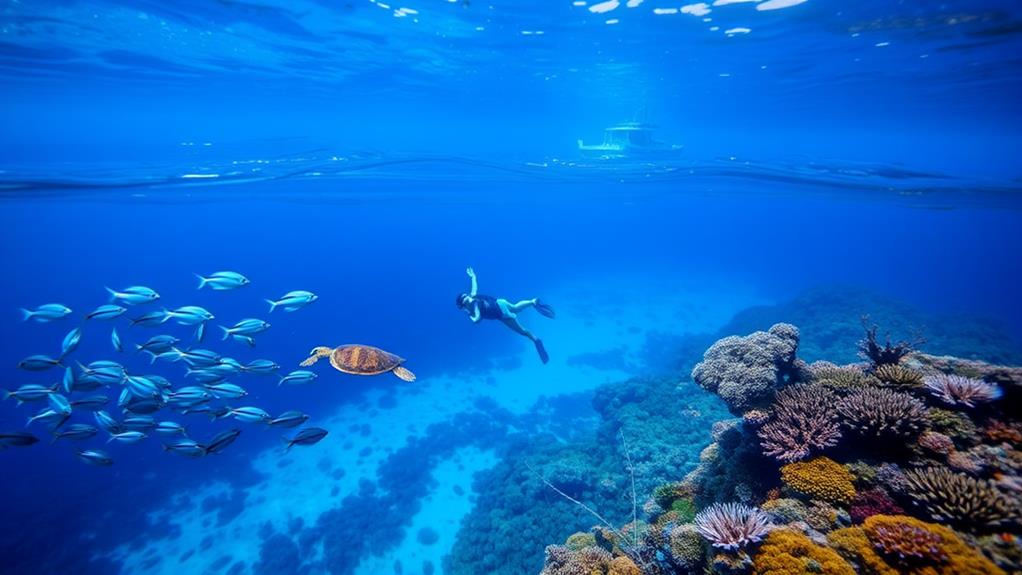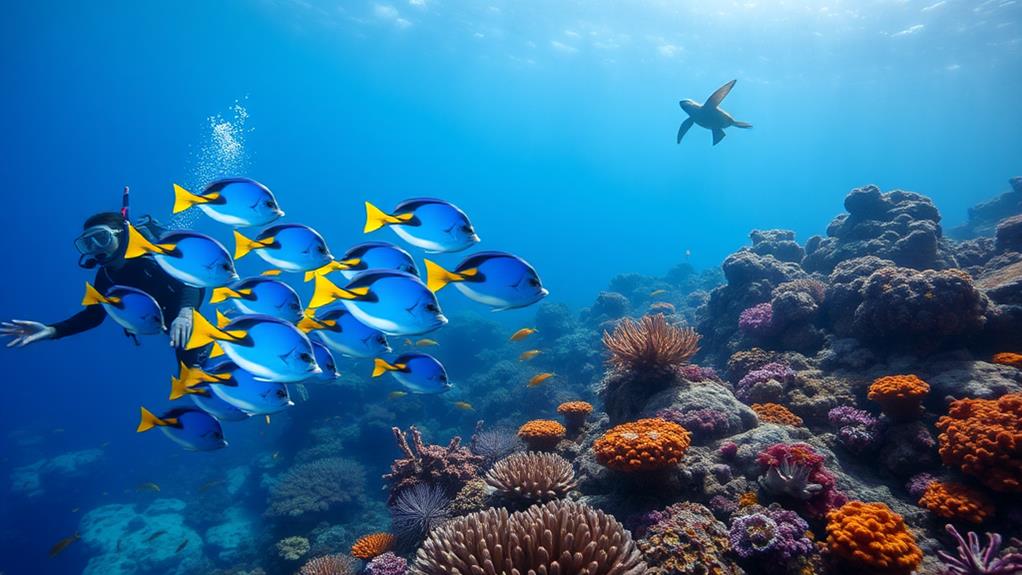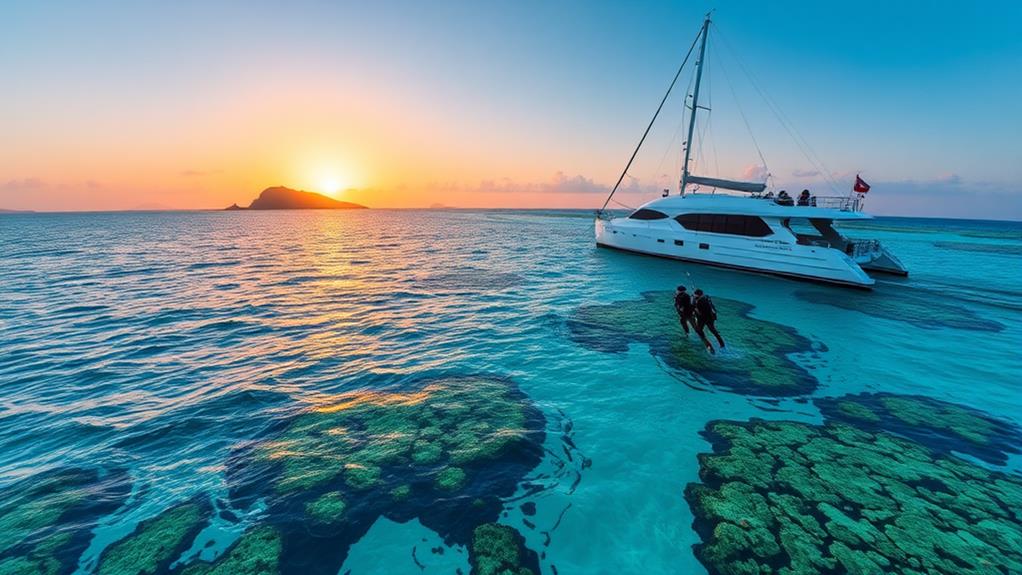Tubbataha Reefs Natural Park is a 96,828-hectare marine protected area in the Philippines that boasts an incredible array of marine life.
Over 1,200 species of marine life inhabit this UNESCO World Heritage Site, including 360 coral species and nearly 700 species of fish. This diversity is due to the park's pristine coral reefs and vibrant ecosystems.
The park is home to various endangered species, including green and hawksbill turtles. Additionally, eleven species of sharks and eleven species of cetaceans can be found in their natural habitat.
This unique environment provides an ideal location for diving enthusiasts to explore and discover the secrets of the ocean.
Tubbataha's rich biodiversity makes it an ideal location for diving.
The park's vibrant ecosystems support diverse marine life, making it an ideal location for diving enthusiasts. As a result, the park has become a world-renowned diving destination.
Tubbataha Reef Overview and Biodiversity

Tubbataha Reef's vast biodiversity is unparalleled in marine richness. This marine protected area is home to a treasure trove of species, spanning 96,828 hectares across North Atoll, South Atoll, and Jessie Beazley Reef.
The park boasts pristine coral reefs and vibrant marine ecosystems, with over 360 species of coral providing a habitat for nearly 700 species of fish.
Endangered species find refuge in Tubbataha Reef. The reef is home to green and hawksbill turtles, as well as eleven species of sharks and eleven species of cetaceans, highlighting its significance as a critical habitat for marine biodiversity.
Ideal diving conditions allow for an up-close experience of this biodiversity. With its vibrant marine ecosystems, Tubbataha Reef offers a unique opportunity to witness the sheer variety of marine life that thrives in this underwater world.
Ecological Significance and Conservation
Tubbataha Reefs Natural Park's Ecological Significance
Tubbataha Reefs Natural Park is a vital component of the Sulu Sea's marine ecosystem, serving as a natural laboratory for ecological studies.
This park maintains ecological balance through top predator species, which are indicators of ecosystem health. For instance, these predators regulate the population of smaller species, ensuring that no single species dominates the ecosystem.
This balance contributes significantly to fisheries outside its boundaries, as healthy populations of marine organisms can migrate and replenish depleted stocks in other areas.
Conservation Efforts and Achievements
Tubbataha Reefs Natural Park has been recognized internationally and monitored for its State of Conservation since 1997, highlighting its importance and effectiveness in marine conservation efforts.
Designated as a marine protected area in 1988, the park has strong no-take policies that reduce fishing pressure and enhance the integrity of its ecosystems.
The park's conservation achievements have been acknowledged globally, earning it the Platinum Blue Park status in 2017 for its exceptional biodiversity protection efforts. This recognition demonstrates the effectiveness of no-take policies in preserving ecological balance and promoting biodiversity protection, making Tubbataha Reefs Natural Park a model for marine ecosystems.
Management and Protection Efforts

Management and Protection Efforts
The Tubbataha Protected Area Management Board, located approximately 150 kilometers southeast of Puerto Princesa City, Palawan, oversees the management of Tubbataha Reefs Natural Park.
As a marine protected area, the park is protected under national environmental legislation, ensuring stringent no-take policies to prevent overfishing and support ecosystem integrity.
Conservation Efforts
The park's management is committed to conservation efforts, focusing on maintaining the park's exceptional marine biodiversity.
Three key efforts are in place:
Monitoring Marine Biodiversity: Continuous monitoring of marine biodiversity and ecosystem health assesses conservation effectiveness and informs management strategies.
Combating Illegal Activities: Active enforcement against illegal fishing and marine pollution is supported by ongoing community education and sustainable tourism practices.
International Recognition: The park was designated as a marine protected area in 1988 and received the prestigious Platinum Blue Park status in 2017 for its conservation efforts.
Through community education and sustainable tourism practices, the park promotes responsible human interaction with the environment, ensuring the long-term health of the ecosystem.
Tourism Management and Environmental Threats
Effective tourism management is critical to preserving the ecological balance of Tubbataha Reefs Natural Park. To achieve this, the park limits access to liveaboards during the diving season from March to June, preventing overcrowding and environmental degradation.
Tubbataha Reefs Natural Park faces several environmental threats. These include:
- Shipping risks and marine litter pollution, which require immediate regulatory measures and increased enforcement to prevent accidents and waste accumulation.
- Illegal fishing activities, which necessitate collaborative efforts with international organizations to enhance protective measures and prevent harm to marine life.
- Logistical challenges posed by the park's remote location, which demands a well-equipped team to monitor and mitigate environmental threats effectively.
- The need for strengthened marine litter regulations on the High Seas surrounding the park to prevent further degradation and protect the marine ecosystem.
Legislative Protection and Information

Legislative protection is crucial to preserving Tubbataha Reefs Natural Park's ecological integrity. As a legally protected area, the park is shielded from human impacts that could compromise its biodiversity and ecosystem integrity.
Designated as a marine protected area since 1988, Tubbataha Reefs Natural Park enforces strict no-take policies, ensuring the conservation of its rich marine life.
Effective buffer zones around the park mitigate shipping threats, supported by internationally recognized legislation.
The park's management involves collaboration with local and international stakeholders to enhance conservation efforts and address illegal activities.
Information accessibility is facilitated through published nomination files by the State Party and updates from the World Heritage Centre.
As a World Heritage site, Tubbataha Reefs Natural Park's conservation efforts are globally recognized and supported, further solidifying its protected status.
Planning Your Tubbataha Dive Trip
When planning a dive trip to Tubbataha Reefs Natural Park, timing is crucial. The best time to visit is between March and June, when diving conditions are optimal. This period offers exceptional visibility, often exceeding 30 meters, making it ideal for spotting the vibrant marine life.
Liveaboard boats are the only way to access Tubbataha. These boats require a 10-hour journey from Puerto Princesa, Palawan, and booking well in advance is essential due to high demand and limited capacity.
Divers need intermediate to advanced skills to navigate the strong currents present at many dive sites. This level of experience is necessary to ensure safety while diving in the park.
Responsible travel practices are a must. Entrance fees support conservation efforts, and eco-friendly practices should be followed to preserve the pristine marine environment.
Marine Life and Dive Experience

Tubbataha Reefs Natural Park is a biodiversity hotspot, home to over 1,200 species of marine life.
This park is renowned for its incredible array of creatures, including 360 species of coral and 700 species of fish.
The waters are also inhabited by sharks and rays, making it a thrilling destination for divers.
The diving season, from March to June, offers ideal conditions for witnessing the park's rich marine life.
Strong currents during this period create perfect conditions for spotting large pelagic species at dive sites like Shark Airport and Amos Rock.
Here, you can encounter whitetip and blacktip sharks, manta rays, and dog-toothed tunas.
The visibility of over 30 meters (100 feet) allows for an unparalleled underwater experience, making it ideal for capturing stunning photographs of the vibrant coral ecosystems.
The park's remote location and strict no-take policies ensure a pristine environment with minimal human impact.
This allows divers to experience the thrill of diving in an untouched environment, free from human interference.
Best Dive Sites and Diving Conditions
Exploring Diverse Dive Sites
Diving Tubbataha Reefs Natural Park offers a range of unique dive sites, each with its own distinct characteristics.
Some top dive sites to explore include Amos Rock, Shark Airport, Washing Machine, and Malayan Wreck.
Amos Rock is known for its diverse corals and large fish, while Shark Airport is a hotspot for advanced divers to encounter various shark species amidst strong currents.
Washing Machine is famous for its manta rays and sharks, and Malayan Wreck is ideal for macro photography due to its rich nudibranch and crab populations.
Optimal Diving Conditions
The best time to dive in Tubbataha Reefs Natural Park is from March to June, when the sea conditions are calm and visibility can exceed 30 meters (100 feet).
This allows for optimal spotting of the park's abundant marine life.
However, diving conditions can be challenging, with strong currents at certain sites like Shark Airport, making it recommended for intermediate to advanced divers.
The park's unique underwater geography, featuring vertical walls and expansive lagoons, provides a variety of habitats that support its rich marine biodiversity.
Liveaboard Options and Booking

Choosing the Right Liveaboard for Tubbataha Reefs Natural Park
To fully experience the wonders of Tubbataha Reefs Natural Park, you need to plan and book a liveaboard that suits your needs. Various liveaboard options are available, including the luxurious Philippine Siren and Atlantis Azores, catering to different preferences and budgets.
Booking through reputable travel advisors is recommended to secure the best rates and ensure a seamless experience during the peak diving season from March to June.
Liveaboards generally offer all-inclusive packages that cover meals, diving equipment, and guided tours, enhancing the overall diving experience. These packages allow you to focus on exploring the vibrant marine ecosystem of Tubbataha Park without worrying about logistics.
Special promotions are available from certain liveaboards. For example, Thalatta Resort offers a free night with a six-night booking, while Solitude One offers 15% discount on select trips.
How Does The Tubbataha Reefs Natural Park Compare to the Puerto Princesa Subterranean River National Park as a Diving Destination?
The Tubbataha Reefs Natural Park and the Puerto Princesa Subterranean River National Park offer diverse experiences for diving enthusiasts. While Tubbataha boasts vibrant coral reefs and diverse marine life, Puerto Princesa provides the opportunity to explore underground river journey while marveling at unique limestone formations.
Conservation Status and Recognition
Conservation Status and Recognition
Tubbataha Reefs Natural Park has been a UNESCO World Heritage Site since 1993, recognizing its exceptional biodiversity and conservation strategies. As a marine protected area, it's home to over 1,200 marine species, including threatened species like the green sea turtle and the critically endangered hawksbill turtle.
The park has received notable recognition for its conservation efforts, including:
- Designated as a UNESCO World Heritage Site in 1993, acknowledging its unique biodiversity and conservation strategies.
- Awarded the Platinum Blue Park status in 2017, recognizing its effective conservation measures and biodiversity protection efforts.
- Classified as a marine protected area, with strict no-take policies implemented to prevent overfishing and maintain ecological integrity.
- Continuous monitoring and research programs are conducted to assess the health of marine biodiversity and enforce regulations against illegal fishing activities within the park.
These efforts demonstrate the park's commitment to preserving its rich biodiversity and ensuring the long-term health of its delicate ecosystem.
Frequently Asked Questions
Is It Safe to Dive in Tubbataha Reef?
Diving in Tubbataha Reef can be safe, but only for experienced divers.
Diving in Tubbataha Reef poses challenging conditions, requiring divers to be prepared and take necessary safety precautions.
A thorough briefing with your guide and use of required equipment are essential to minimize risks.
The best time to dive in Tubbataha Reef is from March to June, when optimal weather and visibility conditions prevail.
Guided tours are recommended to ensure a safe and enjoyable experience, allowing you to appreciate the rich marine biodiversity of the reef.
What Is Tubbataha Reef Famous For?
Tubbataha Reef is renowned for its extraordinary marine biodiversity, featuring over 1,200 species.
This unique ecosystem is a haven for eco-tourism, supporting a wide range of marine species, including green and hawksbill turtles.
The reef's vibrant coral reefs make it an ideal destination for underwater photography.
Its exceptional conservation efforts have earned it the prestigious Platinum Blue Park status, guaranteeing unforgettable diving experiences in pristine waters.
Is Tubbataha Reef Worth It?
Tubbataha Reef is worth visiting because of its exceptional marine biodiversity. As a diver, you'll have the opportunity to explore an unparalleled array of marine life.
The reef's conservation efforts have maintained a pristine environment, making each dive an unforgettable experience.
The limited travel logistics to the reef actually enhance its exclusivity. Ideal visibility makes it an ideal location for underwater photography, allowing you to capture stunning shots.
By supporting eco-tourism in Tubbataha Reef, you'll contribute to the preservation of local culture.
This unique blend of adventure and responsibility makes Tubbataha Reef an unparalleled destination.
How Much Is the Entrance to Tubbataha Reef?
The entrance fee to Tubbataha Reef is PHP 3,500 for divers and PHP 1,000 for non-divers. These fees support conservation efforts and are required for all visitors.
The fees are valid for the entire diving season, from mid-March to mid-June, allowing multiple entries.
It is essential to check with your liveaboard operator for the latest rates, as they may vary. These fees contribute to responsible tourism and help protect the marine biodiversity of this incredible destination.